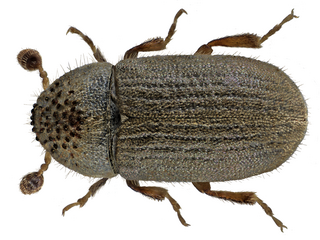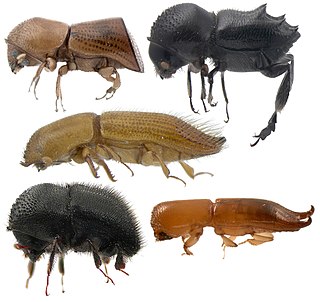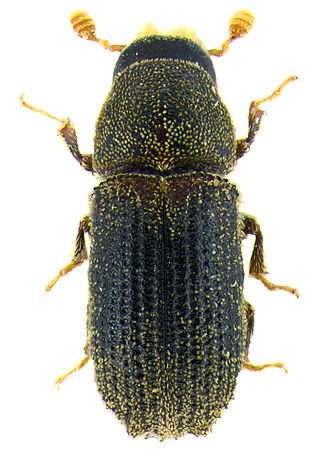Ambrosia beetles are beetles of the weevil subfamilies Scolytinae and Platypodinae, which live in nutritional symbiosis with ambrosia fungi. The beetles excavate tunnels in dead or stressed trees into which they introduce fungal gardens, their sole source of nutrition. After landing on a suitable tree, an ambrosia beetle excavates a tunnel in which it releases its fungal symbiont. The fungus penetrates the plant's xylem tissue, extracts nutrients from it, and concentrates the nutrients on and near the surface of the beetle gallery. Ambrosia fungi are typically poor wood degraders, and instead utilize less demanding nutrients. Symbiotic fungi produce and detoxify ethanol, which is an attractant for ambrosia beetles and likely prevents growth of antagonistic pathogens and selects for other beneficial symbionts. The majority of ambrosia beetles colonize xylem of recently dead trees, but some colonize stressed trees that are still alive, and a few species attack healthy trees. Species differ in their preference for different parts of trees, different stages of deterioration, and in the shape of their tunnels ("galleries"). However, the majority of ambrosia beetles are not specialized to any taxonomic group of hosts, unlike most phytophagous organisms including the closely related bark beetles. One species of ambrosia beetle, Austroplatypus incompertus exhibits eusociality, one of the few organisms outside of Hymenoptera and Isoptera to do so.

Cryphalus is a large genus of tiny bark beetles, subfamily Scolytinae, tribe Cryphalini in the family Curculionidae. The genus is widely distributed. The species feed and breed under the inner bark of trees. They infest mainly recently dead, dying or stressed trees. Some species are regarded as invasive pests, harmful to agriculture or forestry.

Xyleborini are a tribe of ambrosia beetles, highly specialized weevils of the subfamily Scolytinae. Much of the ambrosia beetle fauna in Eurasia and the Americas consists of Xyleborini species. Some Xyleborini are notorious invasive species.

Trypodendron is a genus of ambrosia beetles of the family Curculionidae. There are at least 30 described species in Trypodendron.

Ips is a genus of beetles in the family Curculionidae, the true weevils. They are bark beetles, members of the subfamily Scolytinae. Species are distributed throughout the Northern Hemisphere. Some are known as introduced species in Australia and Africa. Many species are pests of forest trees, especially pines and spruces. They are known commonly as engraver beetles, ips engraver beetles, and pine engravers.

Pseudopityophthorus is a genus of bark and ambrosia beetles in the family Curculionidae. There are more than 30 described species in Pseudopityophthorus, found mainly in North and Central America.
Monarthrum is a genus of typical bark beetles in the family Curculionidae. There are about 5 described species in Monarthrum.

Carphoborus is a genus of crenulate bark beetles within the family Curculionidae. There are at least 40 described species of beetles in Carphoborus.

Xylechinus is a genus of crenulate bark beetles in the family Curculionidae whose 53 described species include:

Pityogenes is a genus of typical bark beetles in the family Curculionidae. There are more than 30 described species in Pityogenes.
Micracisella is a genus of typical bark beetles in the family Curculionidae. There are at least 20 described species in Micracisella.
Premnobius is a genus of typical bark beetles in the family Curculionidae. There are more than 30 described species in Premnobius.
Trischidias is a genus of typical bark beetles in the family Curculionidae. There are about 11 described species in Trischidias.
Cryptocarenus is a genus of typical bark beetles in the family Curculionidae. There are more than 20 described species in Cryptocarenus.

Xyleborinus is a genus of typical bark beetles in the family Curculionidae. There are more than 80 described species in Xyleborinus.

Hylurgops is a genus of beetles belonging to the family Curculionidae. The species of this genus are found in Eurasia and North America.
Cnestus gravidus is a species of weevil found in Bangladesh, Sri Lanka, India, Myanmar, Laos, Thailand, Vietnam and China.

Euwallacea is a genus of typical bark beetles in the family Curculionidae. They are commonly known as Ambrosia beetles, as all species are symbiotic with Ambrosia fungi. Originally from Asia or Wallacea, they are now found worldwide. Many species are pests, causing damage to, or the death of, tree species valued for their fruit or timber.

Cryphalus dorsalis is a small bark beetle, 1.60–1.90 mm long and found in southern parts of Asia with a distribution range from India in the west to Java (Indonesia), the Philippines and southern China in the east. Little information is available on its biology, even on its host plants. In a detailed re-description of the species based on light trap material and specimens without host plant records, Johnson et al. (2020) mentioned that fir (Abies) has been cited as a host plant in one publication which recorded it from Hainan Island (China) where Abies does not grow.

Treptoplatypus is a genus of beetles in the beetle family Curculionidae. There are more than 20 described species in Treptoplatypus.













